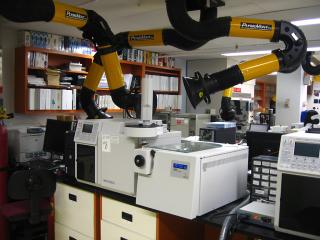
One of the most interesting ongoing developments in materials science involves the borrowing of biologically originated materials and processes. The development is old news for people who follow science news, but seems worth mentioning to others.
In the first instance, there is the copying of chemical tricks that exist in nature. People have speculated about copying the wall sticking abilities of gecko feet, for instance. By artificial producing structures similar to those on the feet, excellent non-chemical adhesives could be made. Gecko feet are sufficiently adhesive to hold several hundred times the weight of the animal. Furthermore, they can be attached and detached at will by altering the geometry of the setae that produce the adhesion using Van der Waals force.
In the second instance, people have been exploiting biological processes to produce existing things in more effective ways. A favourite way to do this is through pharming: where new genes are introduced into species in order to turn them into pharmaceutical factories. For instance, goats have been genetically engineered to produce an anti-clotting drug in their milk, which can then be extracted, purified, and used by humans. The drug, called ATryn, treats hereditary antithrombin deficiency: a condition that makes people especially vulnerable to deep-vein thrombosis. The principle benefits of using goats are financial, as described in The Economist:
Female goats are ideal transgenic “biofactories”, GTC claims, because they are cheap, easy to look after and can produce as much as a kilogram of human protein per year. All told, Dr Cox reckons the barn, feed, milking station and other investments required to make proteins using transgenic goats cost less than $10m—around 5% of the cost of a conventional protein-making facility. GTC estimates that it may be able to produce drugs for as little as $1-2 per gram, compared with around $150 using conventional methods.
Transgenic goats are also being used to produce spider silk on an industrial scale. That super-strong material could be used in everything from aircraft to bullet-proof vests. Different varieties of spider silk could be used to produce materials with varying strengths and elasticities.
While the former behaviour seems fairly unproblematic (we have been coping from nature for eons), the latter does raise some ethical issues. Certainly, it involves treating animals as a means to greater ends – though that is also an ancient activity. People have generally been more concerned about the dangers to people and the natural world from such techniques: will the drugs or materials produced be safe? Will the transgenic animals escape and breed with wild populations? These are reasonable concerns that extend well beyond the genetic or materials expertise possessed by the scientists in question.
The potential of such techniques is undeniably considerable. One can simply hope that a combination of regulation and good judgment will avoid nightmare situations of the kind described in Oryx and Crake. So far, our genetically modified creatures tend to be inferior to their natural competitors. According to Alan Weisman, virtually all of our crops and livestock would be eliminated by predation and competition in a few years, in the absence of human care and protection. It remains to be seen whether the same will be true of plants and animals that currently exist only in the imaginations of geneticists.






